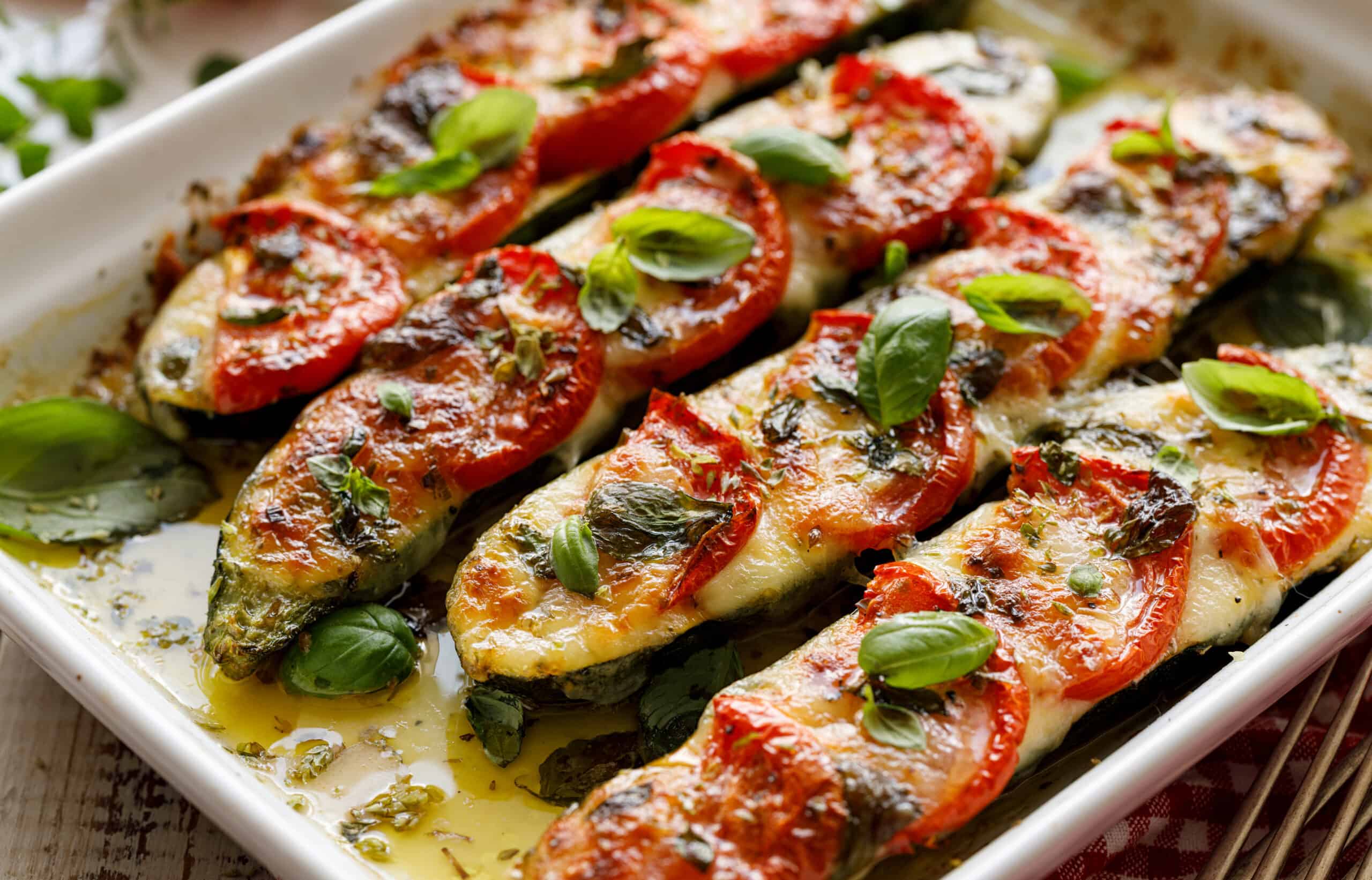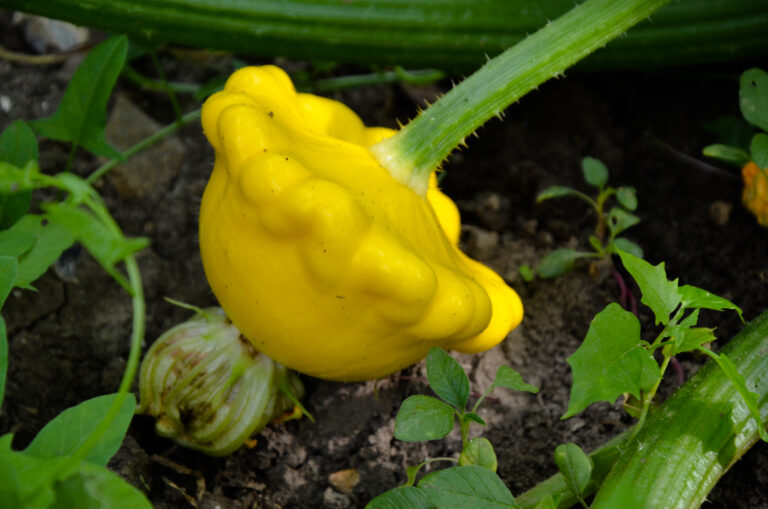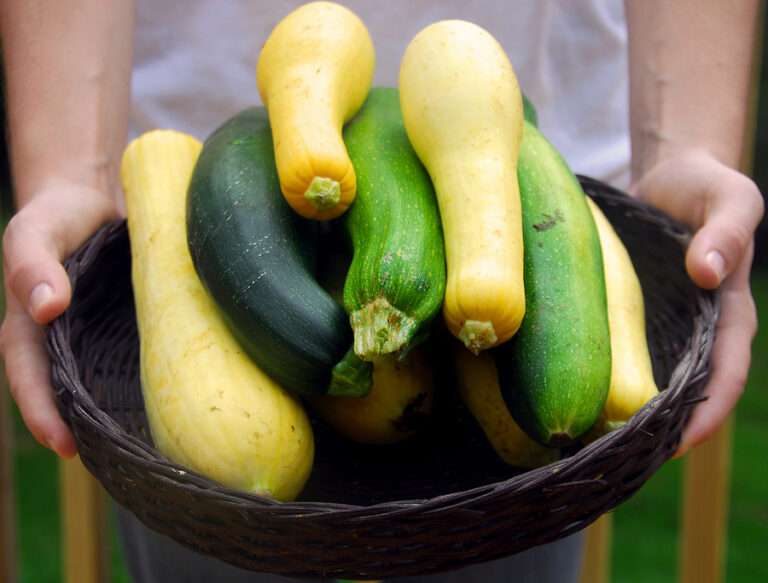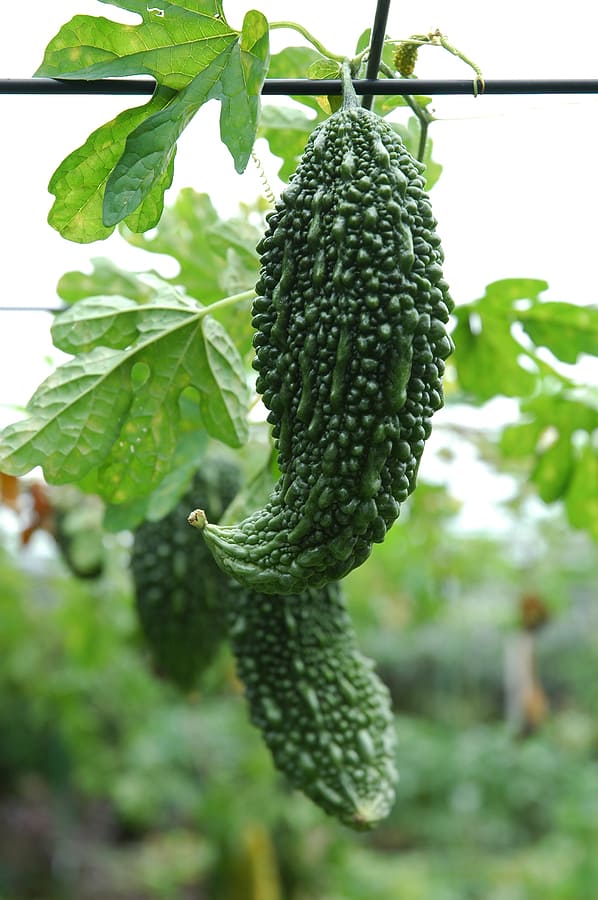Eight Ways to Cook and Serve Summer Squash
Summer or tender squash can be sautéed, steamed, boiled, baked, grilled, microwaved, or eaten raw. Use raw tender squash as an addition to crudités trays and salads
The tender summer squashes–zucchini, Costata Romanesca, round and globe, scallop or pattypan, yellow crookneck, and yellow straightneck, and Zephyr–mature during the summer and can be claimed as baby or mini-squashes in late spring.
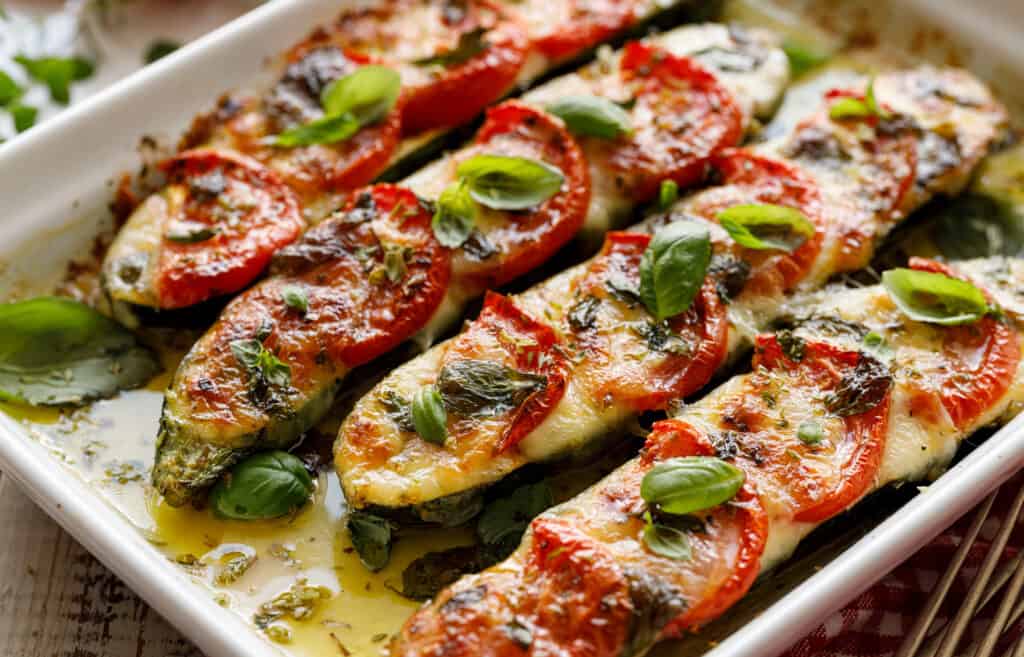
Tender summer squashes are ready for picking as early as 7 days after flowering and are best eaten raw or cooked before they reach maturity while their skins and seeds remain soft and edible.
Tender squashes are soft-skinned and slice easily. They are mild-flavored–even buttery, nutty, or cucumbery tasting. They are high in water content which means that they are perfect for eating raw or cooking quickly–but won’t store long.
(By contrast, winter or hard-skinned squashes–which get their start in the spring and summer along with summer squashes–can not be eaten before they mature. Their skins must grow hard and their flesh starchy before they are ready for cooking. (This, in turn, allows them to be stored and used into the winter–thus the name “winter squash.”)
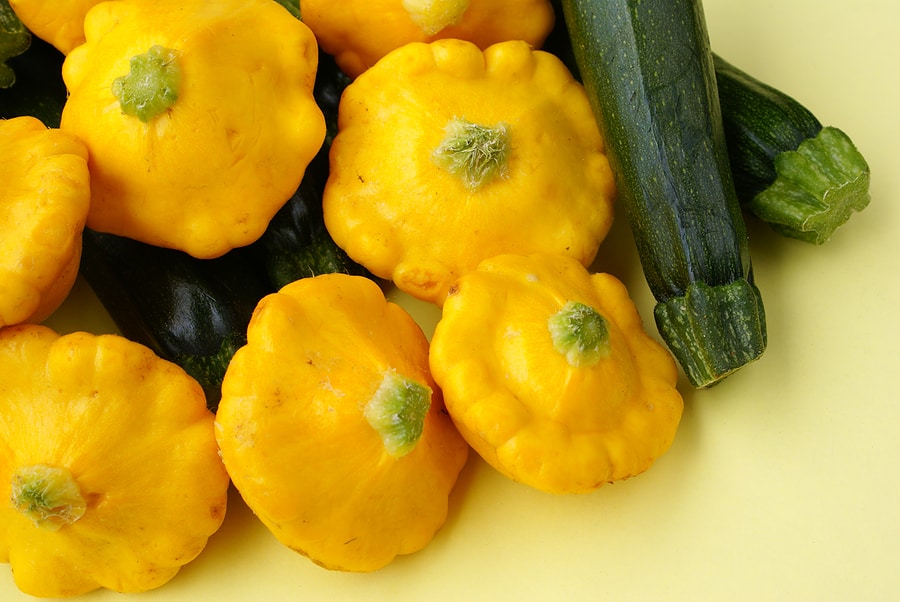
Types of summer squash
- Zucchini is a smooth-skinned, cylindrical squash measuring 2½ to 8 inches (6.4-20 cm) long. The skin color is yellow but a concentration of green pigments gives it an appearance of pale and dark green stripes. Sometimes called the “classic zucchini”, this vegetable resembles a large cucumber. It has a cream-colored watery flesh that can be bland tasting. The name “zucchini” came into general use in California in the 1920s and 1930s. Before that the Italians referred to the same vegetable as “cocozelle” and the French and British called this vegetable “courgette.” A more flavorful variety of zucchini is the golden zucchini which is the same size and shape as the classic green zucchini but with a glossy bright yellow skin. Golden zucchini has a light, buttery flavor.
- Costata Romanesca–sometimes called ribbed Roman zucchini and also called cocozelle–is an elongated slightly bell-shaped, pale green squash with raised ribs that measures 10 to 15 inches (25-38 cm) long and about 5 inches (13 cm) thick in diameter. The green skin is marked by light greenish-yellow stripes that run the length of the vegetable. Costata Romanesca is juicy and sweet flavored but does not keep long. Costata Romanesca is sometimes called marrow squash or vegetable marrow.

Round zucchini or globe squash is about 5 inches (13 cm) in diameter with a skin of varying shades of green. This is a seedless and smooth textured squash that is nearly seedless. It is a juicy and flavorful squash with green-tinted flesh.
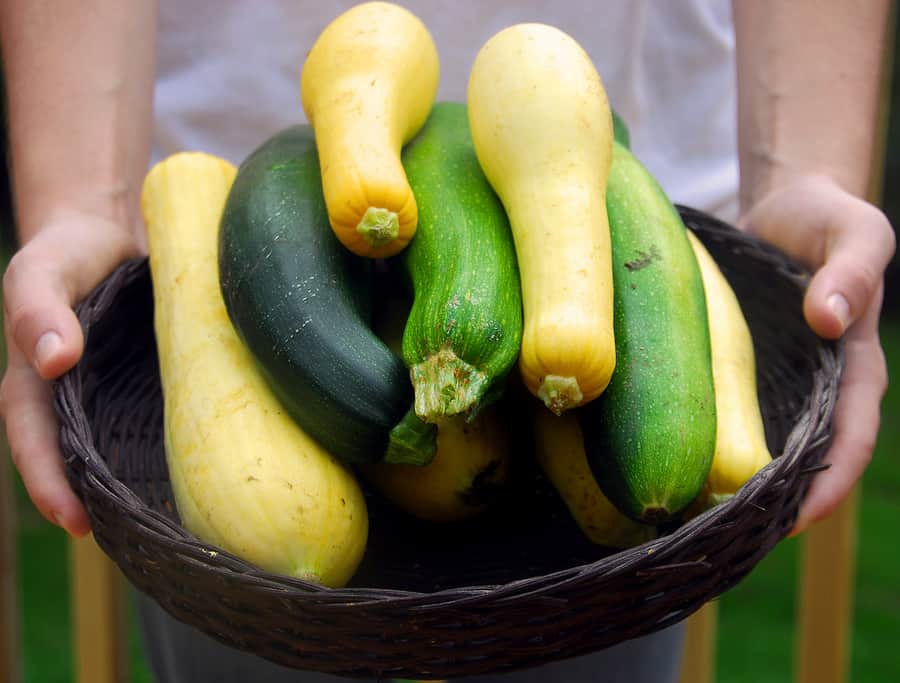
How to choose summer squash
- Select summer squashes that are still tender. Summer squashes that reach maturity will be drier with thicker skins. Choose firm, undamaged squashes with glossy skins free of cracks and blemishes. Select smaller to medium-sized specimens. Overly large squashes tend to be fibrous and bitter, and very small squashes can lack flavor.
- Zucchini and crooknecks that are 5 to 10 inches (13-25 cm) long are good for slicing into rounds; those 3 to 5 inches (7.5-13 cm) long are best for use whole. Yellow varieties are best when 4 to 7 inches (10-18 cm) long.
- Scallop or pattypan varieties are best when 3 to 5 inches (7.5-13 cm) in diameter.
How to store summer squash
- Tender squashes placed in a perforated plastic bag in the refrigerator will keep for about 1 week. Handle summer squash with care because it is easily damaged.
- Summer squash can be frozen but the flesh will be softer when served. Cut the squash into slices and blanch for 2 minutes before freezing. Frozen squash will keep for 3 to 4 months.
How to prep summer squash
- Before eating or cooking, wash and cut off both ends of the squash. Unless the skin is bitter, you do not have to peel tender squash.
- Squash can be used whole, grated, halved, or cut into cubes, strips, or slices. Trim the ends and cut them into chunks or slice them before cooking.
- You can “drain” squash with high water content by cutting it into slices and arranging it in a shallow dish. Then sprinkle the slices uniformly with coarse salt and let drain for 20 to 30 minutes. Use a strainer and rinse the slices under cold running water, pat them dry, and proceed with your recipe.
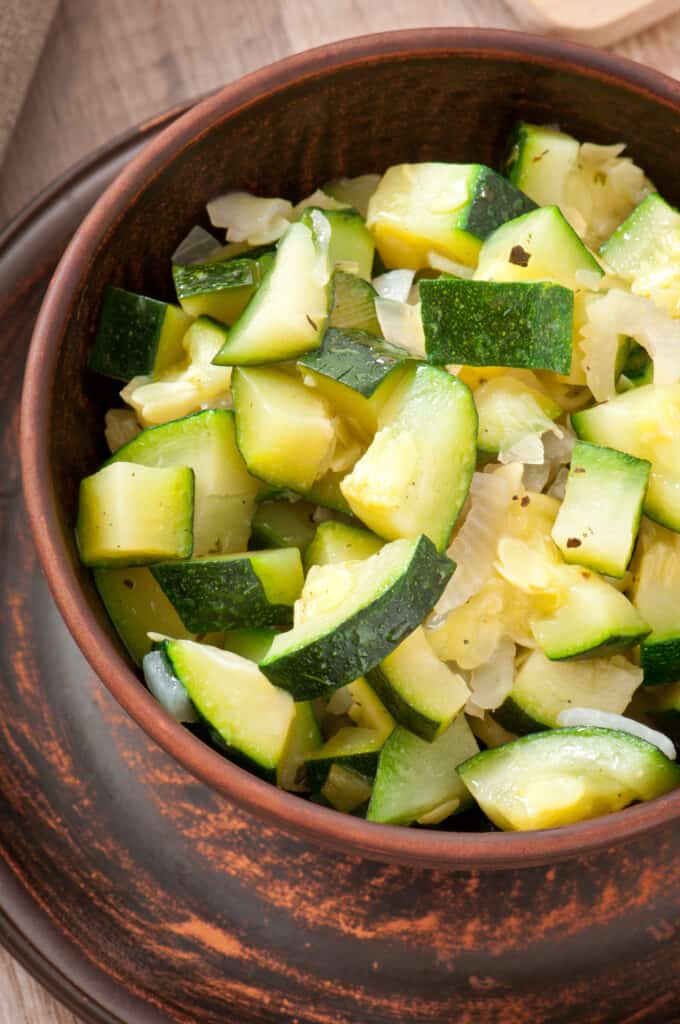
How to steam summer squash
- Prepare halves, slices, or pieces of summer squash.
- Place the squash in a steamer basket in a large saucepan, cover, and let steam over gently boiling water until fork-tender, about 10 to 40 minutes depending on the size of the squash.
- Squash can be steamed with other summer vegetables.
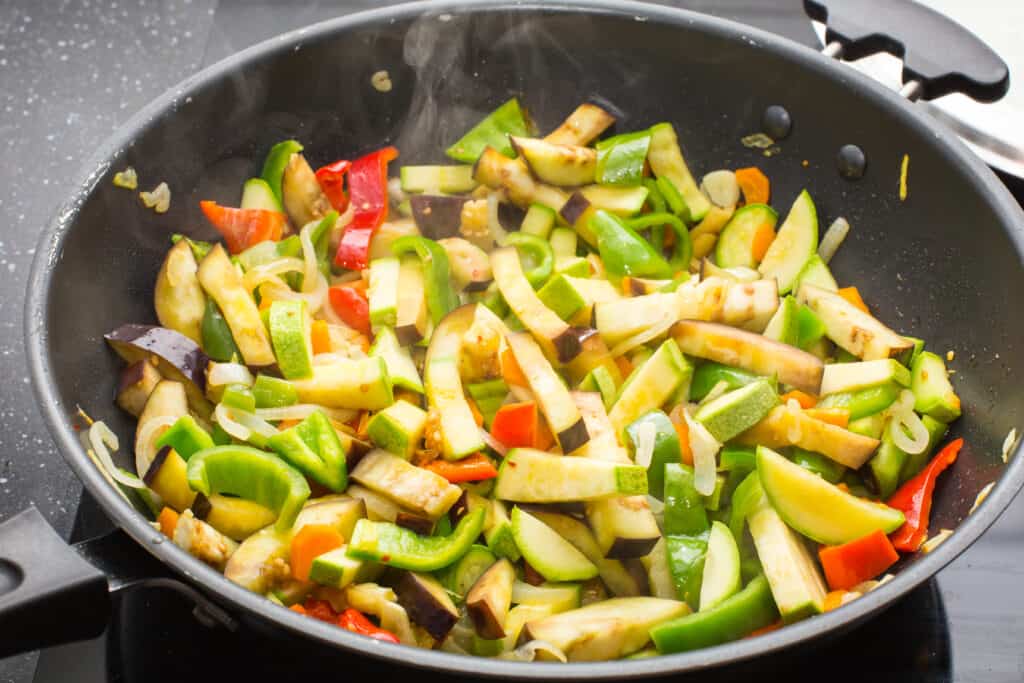
Sauté or stir-fry summer squash
- Cut zucchini or straightneck squash into slices or pieces; the squash can be cooked unpeeled.
- Mix your choice of chopped fresh marjoram, snipped fresh dill, or cumin seed with the zucchini or squash.
- Heat olive oil or a few dabs of butter in a large skillet.
- Add finely chopped yellow onion and brown lightly over high heat.
- Add the squash and stir-fry for 1 minute.
- Cover and reduce the heat and simmer for 5 minutes.
- Add a touch of salt just before serving.
- Squash can also be coated in a wet batter, dipped batter, or seasoned dry coating and fried until the crust is golden brown.
How to boil summer squash
- Cut squash into ½ to ¾ inch cubes.
- Place the squash in a large pot and just cover it with water.
- Cook over medium heat until tender, about 10 to 15 minutes.
Chicken base, garlic, and pepper can be added to the water when the water starts to simmer. Butter can be added just as the squash becomes tender.
Whole squash can be boiled; first, poke holes in the squash with a fork.

How to pan-sear summer squash
- Cut the squash into slices or ½ to ¾ inch cubes.
- Heat olive oil in a deep skillet (preferably cast iron) over high heat until shimmering hot.
- Arrange the squash in the skillet in a single layer.
- Season with salt and freshly ground black pepper. Sprinkle the rosemary over the squash.
- Sear the squash until deep golden brown, 3 to 5 minutes.
- Use tongs to turn the squash, and sprinkle again with salt and pepper to taste.
- Cook until tender and nicely browned on the second side, about 2 minutes more.
- Serve hot.
How to bake summer squash
- Preheat the oven to 350 degrees F.
- Cut unpeeled squash in half or quarters or cut into 1/2-inch round slices; remove the seeds if you like.
- Put a little oil or butter in the cavity of halved squash; add salt and pepper or seasoning; pour a little water, orange juice, or lemon juice into the cavity.
- Halves will cook faster if placed flesh side down and baked for about half the time, then turned and basted with butter or margarine.
- Place the squash in a baking dish with ¾ to 2 inches of water.
- Bake until tender, about 30 to 60 minutes depending on the size.
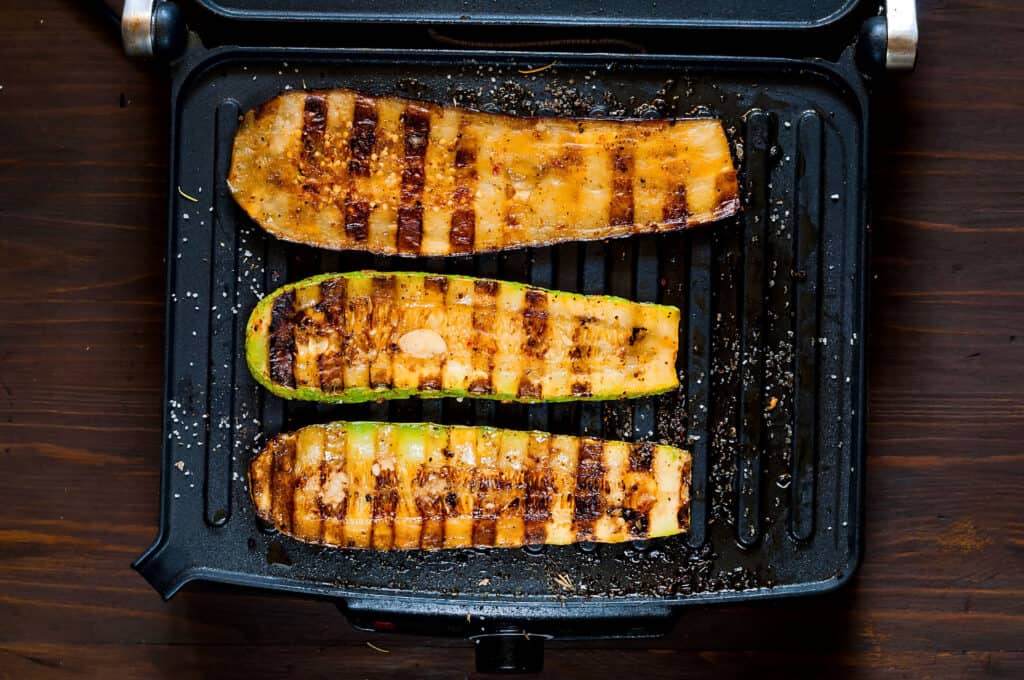
How to grill summer squash
- Preheat grill for medium-high heat.
- Halve zucchini or squash, but do not peel.
- Brush squash with olive oil (or other basting sauce) and season with salt, pepper, and garlic powder or other seasonings.
- Place squash on the grill and cook about 5 minutes on each side, basting frequently with olive oil or a basting sauce.
You can also place the zucchini or squash on a large sheet of aluminum foil, dot it with butter, then fold the foil over, seal the squash in the foil, and cook until tender, about 20 minutes.
How to microwave summer squash
- Halve the squash and remove the seeds.
- Cover the halved squash with plastic wrap; leave one corner open.
- Cook on high until tender 10 to 15 minutes.
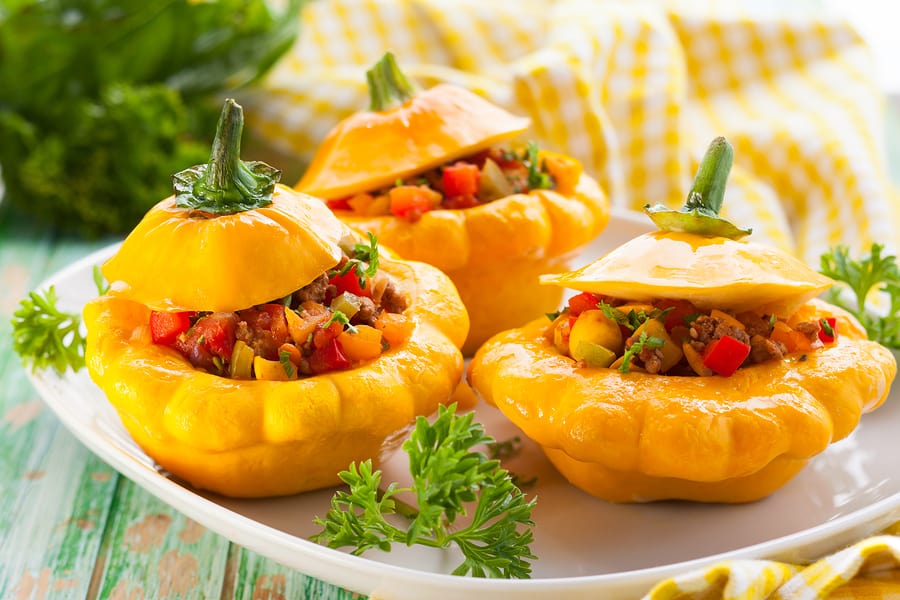
How to stuff summer squash
Prepare the stuffing: warm 1 tablespoon oil in a large skillet over medium-high heat. Add onions and cook, stirring often, until softened, about 3 minutes. Add ground beef, chicken, or turkey and cook, stirring, about 2 to 3 minutes. Mix in diced tomatoes, 1/2 cup chicken broth, and seasoning. Increase heat to high and cook, stirring often, until meat is thoroughly cooked and some of the liquid has evaporated, 5 to 7 minutes. Season with salt and pepper.
- Bring a pot of salted water to a boil.
- Cut squash or zucchini in half lengthwise; place in boiling water. Bring back to a boil and cook until just tender, about 5 minutes.
- Transfer squash to a bowl of ice water. Cool for 2 minutes. Remove and pat dry.
- Preheat oven to 425 degrees F.
- Scrape the seeds and pulp from each squash half, leaving a large cavity for stuffing.
- Brush olive oil on the inside of the squash cavity.
- Arrange the squash halves in a lightly oiled ovenproof baking dish.
- Place equal amounts of filling in each squash half.
- Mix bread crumbs with Parmesan, then sprinkle this over the squash and drizzle lightly with olive oil.
- Bake until golden brown on top, about 20 minutes.
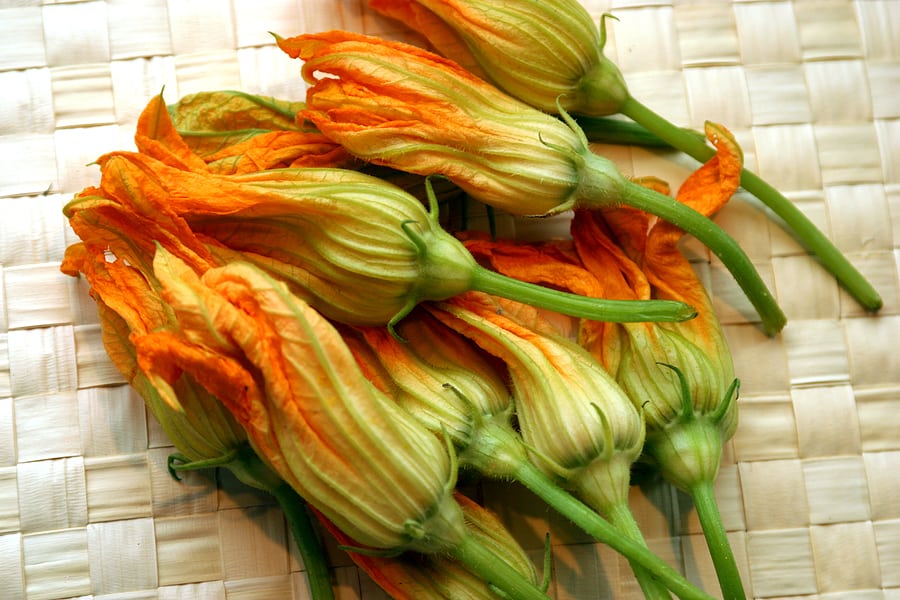
How to cook squash blossoms
Instruction to saute or deep fry squash blooms is here:
Squash Blossoms Sauteed or Deep Fried
How to prepare Costata Romanesca squash
Costata Romanesca is an heirloom Italian squash often considered the best-tasting and best-textured summer squash. It is sometimes called cocozelle or ribbed Roman zucchini. It is also called courgette, marrow squash, and vegetable marrow.
Costata Romanesca is an elongated squash with dark green skin marked by greenish-yellow stripes that run its length. The squash measures 10 to 15 inches (25-38 cm) long and nearly 5 inches (13 cm) in diameter at full growth. Slightly raised ribs run the length of Costata Romanesca and it can sometimes be lightly flecked.
Costata Romanesca is juicy and sweet-nutty flavored. It can be picked tiny and eaten whole; otherwise, it is best to harvest this summer squash at 7 to 10 inches long. Even at 15 inches long Costata Romanesca remains tender and flavorful. The male blossoms of this squash can be stuffed or breaded, cooked, and eaten.
Prepping
- Before eating or cooking, wash and cut off both ends of the squash. Unless the skin is bitter, you do not have to peel tender squash.
- Squash can be used whole, grated, halved, or cut into cubes, strips, or slices.
- Trim the ends and cut them into chunks or slice them before cooking.
- You can “drain” squash with high water content by cutting it into slices and arranging it in a shallow dish. Then sprinkle the slices uniformly with coarse salt and let drain for 20 to 30 minutes.
- Use a strainer and rinse the slices under cold running water, pat them dry, and proceed with your recipe.
Cooking
- Costata Romanesca is a good choice for steaming, sautéing, and grilling.
- Steam halves, slices, or pieces on a steam rack in a large saucepan until tender, about 15 to 40 minutes.
- Sauté or stir-fry cut pieces in olive oil until the pieces are tender.
- Pan-fry or deep fat-fry cubes or slices coated in a wet batter, dipped batter, or seasoned dry coating until the crust is golden brown.
- Grill in 5 to 20 minutes depending upon the size: halves will cook faster if placed flesh side down and basted with olive oil or with butter or margarine.
Serving
- Use small raw Costata Romanesca squash as an addition to crudités trays and salads. Serve sliced raw tender squash with a dip. Slice thinly and add to appetizers, salads, or sandwiches.
- Coat with butter, wrap in foil, then barbeque or bake.
- Halve then stuff with a meat or rice mixture, or bake with butter and Parmesan cheese.
- • Add to soups, stews, quiches, or omelets.
- Brush halves with olive oil and grill.
Costata Romanesca has been called the “classic zucchini.” Before many hybrid summer squashes were introduced, Costata Romanesca was widely grown. The name “zucchini” came into general use in California in the 1920s and 1930s when Italian immigrants began to grow the Costata Romanesca widely and were looking for a simple name. “Zucca” is the Italian word for squash; “zucchini” is the diminutive masculine plural.
How to prepare zephyr squash
‘Zephyr’ is a straightneck summer squash. ‘Zephyr’ has a yellow stem end and is pale green at the blossom end. Faint white stripes run the length of this squash.
Zephyr is a hybrid of a yellow crookneck with a squash that is a cross between the Delicata and yellow Acorn squashes. It has a slightly bowed neck about 5 to 8 inches (13-20 cm) long. You can harvest ‘Zephyr’ at about 4 to 6 inches. ‘Zephyr’ is a firm, sweet-nutty flavored squash perfect for quick cooking.
Prepping
- Before eating or cooking, wash and cut off both ends of the squash. Unless the skin is bitter, you do not have to peel tender squash.
- Squash can be used whole, grated, halved, or cut into cubes, strips, or slices. Trim the ends and cut them into chunks or slice them before cooking.
- You can “drain” squash with high water content by cutting it into slices and arranging it in a shallow dish. Then sprinkle the slices uniformly with coarse salt and let drain for 20 to 30 minutes. Use a strainer and rinse the slices under cold running water, pat them dry, and proceed with your recipe.
Cooking
- Simmer until the flesh can be pierced easily with a knife blade. Whole or unpeeled squash should simmer for 10 to 20 minutes; pieces will cook in 5 to 10 minutes.
- Boil pieces cut into ½ to ¾ inch cubes; use little water; cook 10 to 15 minutes or until tender. Boiling can make squash taste watery and detract from its flavor.
- Boil whole, unpeeled squash covered with water for about 1 hour. First, poke holes in the squash with a fork.
- Steam halves, slices, or pieces on a steam rack in a large saucepan until tender, about 15 to 40 minutes.
- Sauté or stir-fry cut pieces coated with batter until the pieces are tender.
- Pan-fry or deep fat-fry cubes or slices coasted in a wet batter, dipped batter, or seasoned dry coating until the crust is golden brown.
Serving
- Serve with tender squash alone or topped with plain or flavored butter or margarine or with white sauce.

Summer squash serving suggestions
- Tender, summer squash can be eaten raw or cooked.
- Serve sliced raw tender squash with a dip. Slice thinly and add to appetizers, salads, or sandwiches.
- Grate raw squash and mix with eggs, flour, and seasonings to make crêpes.
- Use in entirety or slice then steam, boil, broil, bake, or grill.
- Coat with butter, wrap in foil, then barbeque or bake.
- Halve then stuff with a meat or rice mixture, or bake with butter and Parmesan cheese.
- Pan-fry slices.
- Sauté half-moons in olive oil with garlic, onions, or tomatoes.
- Add sliced zucchini and mushrooms to a thick tomato sauce for spaghetti.
- Stuff and bake.
- Serve gratinéed (with butter and bread crumbs), braised, fried in batter or bread crumbs, or roasted.
- Add to soups, stews, quiches, or omelets.
- Brush with olive oil and grill.
Summer squashes can replace cucumber in most recipes but are less flavorful.
Squash flowers are edible with a delicate flavor and aroma. Quickly sauté blossoms over high heat or stuff and bake.
Summer squash flavor partners
- Tender squash has a flavor affinity for basil, chives, corn, dill, eggplant, feta, fish, garlic, marjoram, mint, mozzarella, olive oil, goat cheese, onion, oregano, pasta, rice, thyme, and tomatoes.
- Season tender squash with salt, pepper, onion, garlic, basil, dill, mustard, oregano, thyme, parsley, marjoram, cardamom, ginger, cinnamon, allspice, nutmeg, mace, cloves, coriander, cumin, curry powder, anise, rosemary, or fennel.
- Serve with tender squash alone or topped with plain or flavored butter or margarine or with white sauce.
Summer squash nutrition
- Summer squash is a good source of vitamins A and C and niacin.
- A cooked half-cup of tender squash contains 14 calories.

Get to know summer squash
- Tender squashes are warm-season annuals. They are weak-stemmed plants that usually grow as a bush. Tender squash has large, lobed cucumber-like leaves that are covered in small prickles.
- The fruits of tender squashes are almost always eaten in an immature state before the skin hardens. Summer squashes are for warm weather harvest and are eaten when immature.
- Squashes are in the same family as the melon and cucumber. Cultivated squashes are descended from wild squashes which originated in the American tropics–between Mexico and Guatemala.
- Squash has been cultivated for more than 10,000 years. The ancient Aztec, Incan, and Mayan peoples considered squash one of the “three sisters” that should be grown together–corn for its stalk, beans that climb the corn, and squash to creep along the surrounding ground to keep the weeds away.
- The name squash is an abbreviation of the Native American word askutasquash meaning eaten raw or uncooked.
The botanical name for tender squash is Cucurbita pepo.
Related posts you might find helpful:
Summer Squash
- How to Grow Summer Squash and Zucchini: A Gardener’s Guide
- Planting and Growing Summer Squash
- Summer Squash Care and Maintenance
- The Best Summer Squash & Zucchini Varieties for Your Garden
- How to Harvest and Store Summer Squash
- Eight Ways to Cook and Serve Summer Squash
Winter Squash
- The Ultimate Guide to Growing Winter Squash
- Planting and Growing Winter Squash
- Winter Squash Care and Maintenance
- The Best Winter Squash Varieties for Your Garden
- Harvesting & Storing Winter Squash for Long-Term Use
- Seven Ways to Cook and Serve Winter Squash
Squash Planting and Care
- Squash Seed Starting Tips: How to Grow Strong, Healthy Plants from the Start
- How to Maximize Squash Pollination for Bigger Harvests
- Growing Squash in Small Spaces: Trellising & Container Growing
- How to Prevent and Treat Squash Pests and Diseases Naturally
- Squash Vine Borer Organic Pest Control
- Squash Bug Organic Pest Control
Books to help you grow:
- Vegetable Garden Almanac & Planner
- Kitchen Garden Grower’s Guide Vegetable Encyclopedia
- Vegetable Garden Grower’s Guide
- Tomato Grower’s Answer Book
Squash articles at Harvest to Table:
How to Grow Summer and Winter Squash
How to Plant and Grow Pumpkins
How to Harvest and Store Summer Squash
How to Harvest, Cure, and Store Winter Squash
How to Harvest and Store Pumpkins
Eight Ways to Cook and Serve Summer Squash
Seven Ways to Cook and Serve Winter Squash
How to Make Creamy Pumpkin Soup
How to Cook and Serve Squash Blossoms
Squash Growing Problems: Troubleshooting
Squash Vine Borer Organic Pest Control
Squash Bug Organic Pest Control
Corn, Beans, and Squash: The Three Sisters
Articles of interest:
Best Herbs for Container Growing
Garden Planning Books at Amazon:
- Vegetable Garden Almanac & Planner
- Kitchen Garden Grower’s Guide Vegetable Encyclopedia
- Vegetable Garden Grower’s Guide
- Tomato Grower’s Answer Book
More kitchen tips:
Bring your harvest to the table. Kitchen prep tips and easy recipes for the vegetables you grow. Click below for vegetable prep and recipes you can use now.
- Almonds
- Apples
- Apricot
- Aprium
- Artichoke
- Arugula
- Asparagus
- Avocado
- Bamboo Shoots
- Banana
- Basil
- Beans, Dried
- Beans. Long
- Beans, Shell
- Beans, Snap
- Beets
- Bitter Melon
- Blackberry
- Bok Choy
- Broccoli
- Broccoli Raab
- Brussels Sprouts
- Cabbage
- Cardoon
- Carrots
- Cauliflower
- Celeriac
- Celery
- Chard
- Chayote Squash
- Cherimoya
- Cherries
- Chestnut
- Chickpea
- Chinese Cabbage
- Chives
- Cilantro
- Citron
- Clementine
- Collards
- Coriander
- Corn, Sweet
- Corn, Baby
- Corn Salad, Mache
- Cranberry
- Cress
- Cucumber
- Daikon
- Dandelion
- Dill
- Eggplant
- Endive, Belgian
- Endive and Escarole
- Fava Beans
- Fig
- Florence Fennel
- Garlic
- Ginger
- Grapefruit
- Grapes
- Guava
- Horseradish
- Jerusalem Artichoke
- Jicama
- Jujube
- Kale
- Kiwifruit
- Kohlrabi
- Kumquat
- Leeks
- Lemongrass
- Lemons
- Lettuce
- Lime
- Mache (Corn Salad)
- Mandarin Orange
- Mango
- Maple Syrup
- Marjoram
- Melons
- Michihili
- Mint
- Mizuna
- Mushrooms
- Mushrooms, Cremini
- Mustard Greens
- Napa Cabbage
- Nectarine
- Okra
- Olives
- Olive oil
- Onions
- Oranges
- Oregano
- Parsley
- Parsley Root
- Parsnips
- Passion Fruit
- Pawpaw
- Peaches
- Pears
- Peas, Garden Snap
- Peas, Snow
- Pei Tsai
- Peppers, Chili
- Peppers, Sweet
- Persimmon
- Pineapple
- Pineapple Guava
- Plantain
- Plums
- Pluots
- Pomegranate
- Potatoes
- Prickly Pear
- Pumpkin
- Quince
- Radicchio
- Radishes
- Raspberries
- Rosemary
- Rhubarb
- Rutabaga
- Sage
- Salsify
- Sauerkraut
- Savory
- Shallots
- Sorrel
- Spinach
- Squash, Summer
- Squash, Winter
- Strawberries
- Sunchokes
- Sunflower
- Sweet Potato
- Swiss Chard
- Tangerine
- Taro
- Tarragon
- Thyme
- Tomatillo
- Tomato
- Turnip
- Turnip Greens
- Yams

